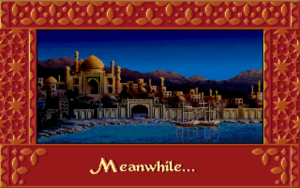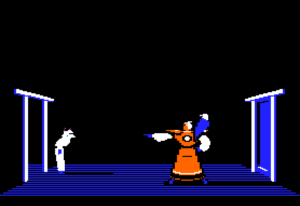 It’s been a while since your game’s scheming villain has actually shown up. There’s a good reason for that–you know the player will try to kill her as soon as she appears, and there’s only so many times you can place her beyond a uncrossable chasm or behind a force field. But you still want to remind the player she exists and show her behind-the-scenes plotting.
It’s been a while since your game’s scheming villain has actually shown up. There’s a good reason for that–you know the player will try to kill her as soon as she appears, and there’s only so many times you can place her beyond a uncrossable chasm or behind a force field. But you still want to remind the player she exists and show her behind-the-scenes plotting.
Or maybe your game adaptation of the Odyssey needs some Penelope scenes to reinforce that, yes–Penelope is pretty awesome and worth fighting monsters and gods to return to. You want to show how she’s handling her own troubles back home to inspire the player.
Or maybe you want to show Sidekick Guy getting murdered back at the base while the player is out on a mission. Or maybe you want to show the Great Dragon slowly awakening beneath the earth. Or maybe…
…well, you get the point. You want to switch away from the player’s point of view and use a cutscene to provide information or atmosphere you couldn’t otherwise get across. In a film, you wouldn’t think twice about it.
Here’s my advice: Think twice. That’s not to say you shouldn’t switch viewpoints for a cutscene in a video game. The advantages are obvious (and pretty much the same as they are in traditional, non-interactive media–thus, not worth discussing in great detail here) but there’s a lot to consider before you jump in.
First, be aware that a viewpoint-changing cutscene reduces the primacy of the Player Character. You are quite literally “breaking immersion” (a term I normally avoid, but a relevant one here) by shattering the tie between the player and the Player Character; what I see is no longer what the character sees, and we no longer share a mind and a common viewpoint. Generally speaking, a tight player-Player Character bond is to your benefit and the consequences of violating that bond are subtle but real–you’re signaling the player, intentionally or not, that this is not purely his or her story.
Second, consider whether the information delivered in the cutscene–a cutscene presumably not witnessed by the Player Character–would change how I as the player want to act as the Player Character. If I know that the story’s villain has placed a traitor among my Player Character’s companions, then I’m going to feel helpless and frustrated if the Player Character still treats his or her buddies like trusted allies. In a film or novel, the notion of a secret traitor would generate tension; it arouses concern for the characters on the part of the audience. In a game, it emphasizes my detachment from the Player Character and blocks my full emotional integration into his or her journey.
 The funhouse mirror version of this scenario involves the Player Character emotionally reacting to situations shown in cutscenes as if he or she had seen them. This is less frustrating for the player, but it’s still a bizarre and distracting violation of character–if you show, say, the charismatic city mayor cackling evilly in a cutscene, then have my police investigator Player Character treat him with suspicion when they meet for the first time, I’m going to wonder why my character is so surly and paranoid. Sure, I know the mayor’s corrupt, but my character sure shouldn’t!
The funhouse mirror version of this scenario involves the Player Character emotionally reacting to situations shown in cutscenes as if he or she had seen them. This is less frustrating for the player, but it’s still a bizarre and distracting violation of character–if you show, say, the charismatic city mayor cackling evilly in a cutscene, then have my police investigator Player Character treat him with suspicion when they meet for the first time, I’m going to wonder why my character is so surly and paranoid. Sure, I know the mayor’s corrupt, but my character sure shouldn’t!
These are extreme examples, but less over-the-top versions aren’t hard to think up. If two NPCs are chatting enigmatically in a cutscene and delivering foreshadowing, and I can’t ask them about it when I’m in control of the Player Character? I’m not intrigued–I’m frustrated! On the other hand, if a cutscene contains no new information–if it’s essentially something that the Player Character could have imagined (“the captured prince is sad about being captured!” or “my loved one is worried about me!”)–you avoid this particular trap. A cutscene that contains no actionable information–a cryptic hint at something utterly unrelated to what the player is presently experiencing–is similarly “safer.”
Third, if you do think the advantages of a viewpoint-changing cutscene may outweigh the disadvantages, consider other potential mitigating factors:
- Do you have multiple Player Characters and switch between them already? Then your player-Player Character bond is already relatively weak and viewpoint changes are already integrated into your game’s style. This might reduce the issues with Player Character primacy.
- Can you make the cutscene into an interactive sequence instead? If you’re already violating point of view, you might consider going one step farther and giving the player a new way to emotionally engage with the characters.
- Is your game comedic? Is the cutscene funny? Then you can get away with pretty much anything.
- Is your Player Character something of a cipher anyway? (Maybe he’s a silent protagonist, or her motivations are intentionally unclear.) Then my choice to act on information only available in a cutscene (if such a choice is available) may be less distracting.
- Are you consistent about your use of cutscenes, and do you establish their use early on? Unveiling a single viewpoint-breaking cutscene thirty hours into a forty-hour game is very likely to jar the player. Conversely, if you cut to only one other viewpoint on a regular, predictable basis and start from the beginning (e.g., every time Odysseus leaves an island we get a Penelope cutscene), your player is more likely to become inured to the negative effects.
- The big exception to that last point is introductory cutscenes, which of course come before the player’s point of view has been firmly established! In this way, an introductory cutscene can do all sorts of things a mid-game cutscene might have trouble with.
Try to be aware of all the consequences of your narrative choices and weigh them accordingly. Changing viewpoint isn’t a casual decision in a video game, and while it can certainly be employed adeptly, well… if you’re not sure it’s worth it, you’ve got plenty of other tools available.
